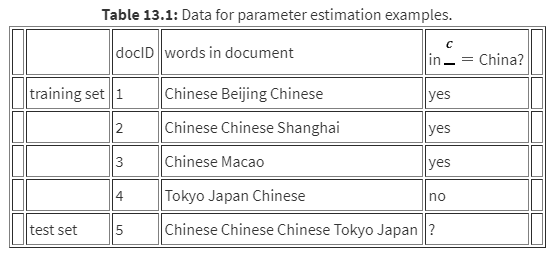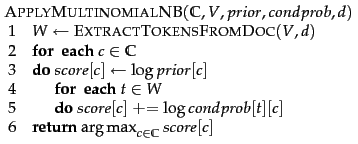[without library] Text Classification using Multinomial Naive Bayes
Multinomial Naive Bayes for Text Classification
Introduction to Information Retrieval - Manning
url: https://nlp.stanford.edu/IR-book/html/htmledition/naive-bayes-text-classification-1.html
Imports
import pandas as pd #input
import numpy as np #counts
#vocabulary, count of tokens
from tensorflow.keras.layers.experimental.preprocessing import TextVectorization
from math import log # to calculate posterior probability
Constants
It is good to have max_tokens higher than vocab_size = len(vocabulary), so that we can make use to all the words in the vocabulary for prediction. Otherwise, only the first max_tokens words of the vocabulary will be used.
max_tokens = 1000
Environment
Naive Bayes dataset - Introduction to Information Retrieval - Manning
url: https://nlp.stanford.edu/IR-book/html/htmledition/naive-bayes-text-classification-1.html

f_train = '../input/naive_bayes_demo_data_china/train.csv'
f_test = '../input/naive_bayes_demo_data_china/test.csv'
f_classes = '../input/naive_bayes_demo_data_china/classes.csv'
cols_train = ['class', 'title', 'body']
cols_test = ['class', 'title', 'body']
cols_classes = ['class_name']
AG News
url: https://github.com/mhjabreel/CharCnn_Keras/tree/master/data/ag_news_csv
f_train = '../input/ag_news_csv/train.csv'
f_test = '../input/ag_news_csv/test.csv'
f_classes = '../input/ag_news_csv/classes.txt'
cols_train = ['class', 'title', 'body']
cols_test = ['class', 'title', 'body']
cols_classes = ['class_name']
Data
df_train = pd.read_csv(f_train,
header=None)
df_train.columns = cols_train
df_test = pd.read_csv(f_test,
header=None)
df_test.columns = cols_test
df_classes = pd.read_csv(f_classes,
header=None)
df_classes.columns = cols_classes
Sanity check for data getting loaded
print(df_train.head(2))
print(df_test.head(2))
print(df_classes.head(2))
Helper Functions
"""
return (vectorizer, list) the vocabulary of words that occur in the documents
arguments:
vec: vectorizer (of type tensorflow.keras.layers.experimental.preprocessing.TextVectorization)
df_docs: dataframe with documents
df_docs_colname: column name of the column having the documents
"""
def extract_vocabulary(vec, df_docs, doc_colname='body'):
#WARNING: https://stackoverflow.com/questions/62679020/error-while-trying-to-save-npy-numpy-file
#VisibleDeprecationWarning: Creating an ndarray from ragged nested sequences (which is a list-or-tuple of lists-or-tuples-or ndarrays with different lengths or shapes) is deprecated. If you meant to do this, you must specify 'dtype=object' when creating the ndarray
vec.adapt(df_docs[doc_colname].values)
return vec, vec.get_vocabulary()
"""
return (number) the number of rows in the dataframe, each row corresponding to a document
arguments:
df_docs: dataframe with documents (can have columns in addition to the document)
"""
def count_docs(df_docs):
return len(df_docs)
"""
return (number) the number of rows in the dataframe belonging to class 'c'
arguments:
df_docs: dataframe with documents (should have a 'class' column in addition to the document)
c: the class for which the document count is sought
class_colname: column name of the column having class name/id
"""
def count_docs_in_class(df_docs, c, class_colname='class'):
return count_docs(df_docs[df_docs[class_colname] == c])
"""
return (string) the concatenated text of all documents of class c
arguments:
df_docs: dataframe with documents (should have a 'class' column in addition to the document)
c: the class for which the documents are sought
df_docs_colname: column name of the column having the documents
class_colname: column name of the column having class name/id
"""
def concatenate_text_of_all_docs_in_class(df_docs, c, doc_colname='body', class_colname='class'):
#for df[class == c] get the 'body' column, convert its type to list,
# and concatenate all lists, separated by space.
return ' '.join(df_docs[df_docs[class_colname] == c][doc_colname].to_list())
'''
return (numpy array) an array of counts of tokens in the text,
each array element corresponding to the count of token at that index in the vocabulary.
arguments:
vec: output_mode="count" based vectorizer
that was 'adapt'ed to the documents to learn the vocabulary.
text: concatenated documents belonging to a certain class
'''
def count_tokens_of_all_terms(vec, text):
counts = vec([[text]])
return counts[0].numpy()
Model
Training Algorithm

'''
return
vectorizer,
prior: 1-d array of dim num_classes
(prior probability of document belonging to class),
cond_prob: 2-d array of dim token x num_classes
(conditional probability for all token, given the class)
arguments:
df_classes: dataframe with class names
df_docs: dataframe with documents (should have a 'class' column in addition to the document 'body' column).
provide suitable column names otherwise, using the doc_colname and class_colname arguments.
'''
def train_multinomial_nb(df_classes, df_docs,
doc_colname='body', class_colname='class'):
#extract vocabulary
#create an instance of TextVectorization
vectorizer = TextVectorization(max_tokens=max_tokens, output_mode="count")
vectorizer, vocabulary = extract_vocabulary(vectorizer, df_docs, doc_colname)
#data structures for prior and conditional probabilities
num_classes = len(df_classes) #number of classes of documents
prior = np.zeros((num_classes), dtype=float) #prior probability of document belonging to a class
vocab_size = len(vocabulary)
cond_prob = np.zeros((vocab_size, num_classes), dtype=float)
#total number of documents, to calculate prior probability of document belonging to a class
N = count_docs(df_docs)
#for each class...
for c in range(num_classes):
cls = c+1 #c is 0-based index, but class is 1-based index
#calculate prior probability of document belonging to class cls
N_c = count_docs_in_class(df_docs, cls, class_colname) #number of document of class cls
prior[c] = N_c / N # (num_docs of class cls / total num_docs)
#calculate likelihood: conditional probability for all token, given this class
#1. concatenate documents of this class
text_c = concatenate_text_of_all_docs_in_class(df_docs, cls, doc_colname, class_colname)
#2. in this concatenated text, get counts for each token
T_ct_all_t = count_tokens_of_all_terms(vectorizer, text_c)
#3. calculate denominator of conditional probability: sigma(T_ct) + |V|
den = T_ct_all_t.sum() + vocab_size
#4 set the likelihood: conditional probability for all tokens, given this class
for t in range(vocab_size):
t_idx = t+1 #vectorizer begins with an OOV, so, add 1 to accommodate OOV
cond_prob[t][c] = (T_ct_all_t[t_idx] + 1)/den
return vectorizer, prior, cond_prob
Prediction Algorithm

'''
return (integer) the (0-based) index of class to which the document belongs
arguments:
df_classes: dataframe with class names
vectorizer
prior: 1-d array of dim num_classes (prior probability of document belonging to class)
cond_prob: 2-d array of dim token x num_classes (conditional probability for all token, given the class)
text: document whose class is to be predicted
'''
def apply_multinomial_nb(df_classes, vectorizer, prior, cond_prob, text):
#count of each token
W = count_tokens_of_all_terms(vectorizer, text)
#vocabulary
vocabulary = vectorizer.get_vocabulary()
vocab_size = len(vocabulary)
num_classes = len(df_classes) #number of classes of documents
score = np.zeros((num_classes), dtype=float)
#for each class, calculate the posterior probability
#for each class...
for c in range(num_classes):
#for this class, add the log-prior probability to the score
score[c] += log(prior[c], 10) #log to the base 10
#for each term, add the log-likelihood to the score
for t in range(vocab_size):
t_idx = t+1 #vectorizer begins with an OOV, so, add 1 to accommodate OOV
T_ct = W[t_idx] #count of number of times this token appeared in text
#for a term appearing multiple times, repeatedly add the log-likelihood to the score
for j in range(T_ct):
score[c] += log(cond_prob[t][c], 10) #log to the base 10
return score.argmax()
Training
#train the model
vectorizer, prior, cond_prob = train_multinomial_nb(df_classes, df_train)
print('vocabulary length is:', len(vectorizer.get_vocabulary()))
print('vocabulary is:', vectorizer.get_vocabulary()[:10])
Prediction
#predict the documents
N = len(df_test)
count_correct, count_incorrect = 0, 0
for i in range(1000):
text = df_test['body'][i] #input document for classification
pred_cls = apply_multinomial_nb(df_classes, vectorizer, prior, cond_prob, text)
actual_cls = df_test['class'][i] - 1 #df_test.class is 1-based index, but df_classes and pred_class are 0-based index
#print('(predicted, actual):', df_classes['class_name'][pred_cls], df_classes['class_name'][actual_cls])
if pred_cls == actual_cls:
count_correct += 1
else:
count_incorrect += 1
print('Correct: ', count_correct, 'Incorrect: ', count_incorrect)
print('Percentage of correct predictions: ', (count_correct * 100)/(count_correct + count_incorrect))